#Roof Ventilator
Explore tagged Tumblr posts
Text
#Wall cladding#Guttering and Downpipes installation#Copper Roofing#Metal Roofing#Roof Replacements#Roof Ventilator
0 notes
Text
Air Roof Ventilators by Shree Sivabalaaji Steels (3SGroups)
When it comes to industrial and commercial construction, ensuring proper ventilation is crucial. A key component in achieving this is the use of air roof ventilators. Shree Sivabalaaji Steels, known as 3SGroups, is a leading distributor and supplier of high-quality air roof ventilators, offering excellent solutions for businesses and industries to enhance airflow, reduce heat buildup, and promote energy efficiency. These ventilators are designed to ensure better air circulation, maintaining optimal indoor conditions in industrial buildings, warehouses, factories, and commercial spaces.

What Are Air Roof Ventilators?
Air roof ventilators are devices installed on the roof of buildings to facilitate the movement of air and prevent the accumulation of heat, moisture, and pollutants inside. These ventilators use natural wind or air pressure differences to extract warm, stale air from the building while allowing fresh air to replace it. This helps in reducing indoor temperatures, improving air quality, and reducing energy consumption by minimizing the need for mechanical cooling systems like air conditioners.
Importance of Air Roof Ventilators
Proper ventilation is essential in any commercial or industrial setup. Air roof ventilators are crucial in maintaining a comfortable and healthy environment for workers and preserving the integrity of the building. Below are some of the benefits of using air roof ventilators:
1. Improved Air Quality
Air roof ventilators help in expelling harmful gases and fumes from industrial processes. These can include smoke, chemicals, or moisture that can degrade both the structure of the building and the health of the people inside. By removing stale air and replacing it with fresh air, these ventilators ensure a continuous supply of clean and breathable air.
2. Energy Efficiency
One of the most significant benefits of air roof ventilators is their ability to reduce energy consumption. By promoting natural airflow, these ventilators reduce the dependency on artificial cooling systems, thereby lowering electricity usage. This not only helps in cutting down energy costs but also makes the building more eco-friendly.
3. Thermal Comfort
In industrial and commercial buildings, temperature control is essential for the comfort and productivity of employees. Air roof ventilators reduce indoor temperatures by allowing hot air to escape from the building and facilitating the entry of cooler outdoor air. This natural cooling process can provide relief from the extreme heat, especially in areas where air conditioning may be expensive or impractical.
4. Prevention of Humidity and Moisture Build-Up
Excess moisture in a building can cause several issues, including the growth of mold and mildew, rusting of metal surfaces, and degradation of building materials. Air roof ventilators help in regulating humidity levels by expelling damp, humid air and reducing the chances of moisture-related problems.
5. Increased Productivity
A well-ventilated environment contributes to the overall well-being of employees. By ensuring proper airflow and temperature regulation, air roof ventilators make the working environment more comfortable. Comfortable conditions lead to improved employee health, fewer distractions, and ultimately, increased productivity.
Types of Air Roof Ventilators Offered by 3SGroups
3SGroups, Shree Sivabalaaji Steels offers a variety of air roof ventilators to suit the needs of different industrial and commercial applications. These ventilators are designed for both large and small-scale facilities, ensuring that each installation improves airflow and ventilation for optimum performance.
1. Turbine Ventilators
Turbine ventilators are one of the most common types of air roof ventilators. They work by harnessing the power of the wind to spin a turbine, which in turn pulls the hot air out of the building. The spinning motion creates a vacuum that draws in cool air, enhancing natural ventilation. Turbine ventilators are highly effective and work even in areas with low wind speeds, making them a popular choice for industrial buildings, warehouses, and factories.
2. Roof Ventilator Systems
3SGroups also offers customized roof ventilator systems that can be designed to meet the specific ventilation needs of any building. These systems often incorporate multiple types of ventilators, exhaust fans, and air ducts to create a comprehensive solution for maximizing airflow.
Why Choose Shree Sivabalaaji Steels (3SGroups)?
Shree Sivabalaaji Steels (3SGroups) stands out in the industry due to its commitment to providing high-quality, durable, and efficient air roof ventilators. Here are a few reasons why 3SGroups is the preferred choice for ventilator solutions:
Superior Quality Products: 3SGroups offers ventilators made from premium materials, ensuring durability and long-term performance.
Customized Solutions: Understanding that every building has unique needs, 3SGroups provides tailored solutions to ensure optimal ventilation.
Energy Efficiency: Their products are designed to maximize airflow while reducing the reliance on energy-intensive systems, helping businesses save on utility costs.
Expert Installation and Support: 3SGroups provides expert installation and ongoing support to ensure your ventilation system operates at peak performance.
Cost-Effective: With 3SGroups, you get top-quality ventilators at competitive prices, ensuring great value for your investment.
Conclusion
Air roof ventilators are essential for maintaining healthy, comfortable, and energy-efficient environments in industrial and commercial buildings. Shree Sivabalaaji Steels (3SGroups) provides high-quality ventilators designed to improve air quality, reduce energy consumption, and ensure the long-term durability of your building. With a variety of options and customized solutions, 3SGroups helps businesses and industries create optimal ventilation systems tailored to their specific needs.
0 notes
Text
I really wish I had thought of opening all the windows to air out the winter funk yesterday when it was 60s instead of today when it’s 40s.
#brrr#I’m having leaking from my skylight#and will need to have my roof replaced in a few weeks/months#and the guy who came by said that I don’t have enough ventilation stacks in my roof#hence why it gets musky#so I get to add that to the price#but maybe it won’t be quite so rank after a few weeks of closed windows
13 notes
·
View notes
Text
Enhancing Home Ventilation with Turbine Roof Vents: The Solution to a Healthier Living Environment
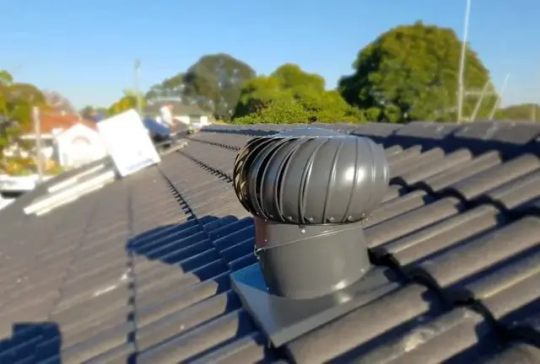
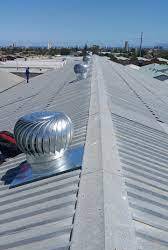
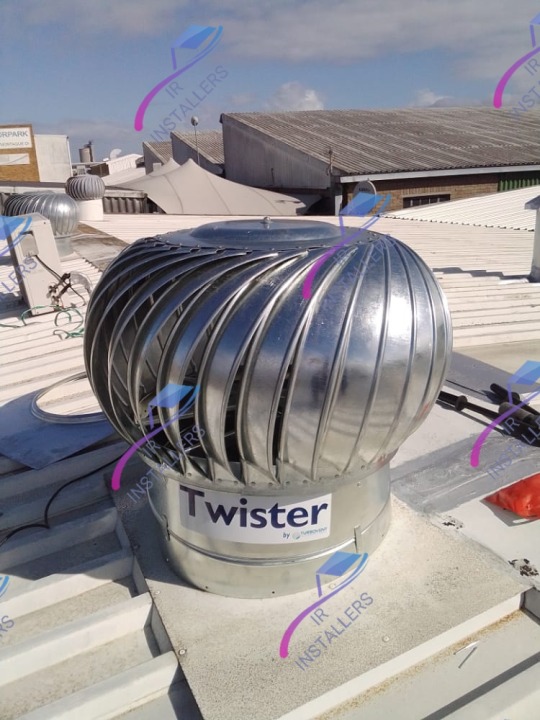
A well-ventilated home is essential for maintaining a healthy and comfortable living environment. Adequate ventilation helps to remove excess moisture, prevent the buildup of indoor pollutants, and regulate indoor temperatures. One innovative solution that has gained popularity in recent years is the turbine roof vent, which offers efficient and natural ventilation for homes. This essay delves into the significance of turbine roof vents as a solution to home ventilation and highlights their benefits. Furthermore, it will explore the advantages of choosing professional installers, particularly those affiliated with IR Installers, to ensure the proper installation of these ventilation systems.
Importance of Home Ventilation
Proper home ventilation is crucial for a variety of reasons. First and foremost, it helps to maintain indoor air quality by reducing the concentration of pollutants and allergens that can accumulate in an enclosed space. These pollutants include volatile organic compounds (VOCs), dust mites, mold spores, and various airborne contaminants, all of which can contribute to respiratory issues and other health problems. Additionally, a well-ventilated home prevents excessive humidity, which can lead to the growth of mold and mildew, causing structural damage and health risks.
Moreover, temperature regulation is a significant factor in home comfort. Adequate ventilation facilitates the circulation of fresh air, helping to prevent heat buildup in the summer and excessive cold in the winter. This, in turn, reduces the reliance on heating and cooling systems, leading to energy savings and a reduced carbon footprint.
Turbine Roof Vents: A Natural Ventilation Solution
Turbine roof vents, commonly referred to as "whirlybirds," are innovative devices designed to harness the power of wind to facilitate natural ventilation in homes. These vents consist of a rotating turbine installed on the roof, which rotates with even the slightest breeze, creating a negative pressure that draws stale air and moisture out of the living space. Fresh air is then drawn in through open windows or other vents, promoting air exchange and maintaining a balanced indoor environment.
One notable advantage of turbine roof vents is their energy efficiency. Unlike electrically powered ventilation systems, turbine vents operate solely based on wind energy, requiring no additional power source. This makes them an eco-friendly option that can significantly contribute to reducing energy consumption and utility costs.
Benefits of Turbine Roof Vents
Turbine roof vents offer a range of benefits that make them an appealing choice for homeowners seeking effective ventilation solutions:
Energy Efficiency: As mentioned earlier, turbine vents are entirely wind-powered, reducing reliance on electricity and promoting sustainable living.
Cost-Effectiveness: The initial installation cost of turbine vents is relatively low compared to other ventilation systems. Additionally, their maintenance requirements are minimal, further lowering long-term costs.
Low Maintenance: Turbine roof vents have few moving parts and are designed to be self-lubricating, requiring little to no maintenance over their lifespan.
Continuous Ventilation: Since they operate based on wind, turbine vents provide continuous ventilation without interruptions, ensuring a steady supply of fresh air.
5. Moisture and Mold Prevention: By expelling humid air, turbine vents help to prevent the growth of mold and mildew, safeguarding both the structural integrity of the home and the health of its occupants.
6. Noise-Free Operation: Modern turbine vents are designed to operate silently, eliminating the potential noise disturbances associated with some mechanical ventilation systems.
The Role of Professional Installers
While turbine roof vents offer a straightforward solution to home ventilation, proper installation is essential to ensure their optimal performance. Professional installers bring expertise and experience to the installation process, ensuring that the vents are correctly placed and securely fastened to the roof. Additionally, professional installers can assess the specific ventilation needs of a home and recommend the appropriate number and placement of turbine vents to achieve the best results.
IR Installers: The Preferred Choice
When considering the installation of turbine roof vents, opting for IR Installers is a prudent choice. IR Installers are recognized as leaders in the industry, specializing in the installation of a variety of ventilation systems, including turbine roof vents. Their affiliation with www.twirlybirds.co.za, a reputable source for quality ventilation products, further establishes their expertise in the field.
By choosing IR Installers, homeowners can benefit from:
Expertise: IR Installers possess a deep understanding of ventilation requirements and can tailor solutions to meet the specific needs of each home.
Professionalism: With a proven track record, IR Installers are known for their professionalism, punctuality, and attention to detail throughout the installation process.
Quality Assurance: The partnership between IR Installers and www.twirlybirds.co.za ensures access to high-quality turbine roof vents, backed by warranties and reliable customer support.
Compliance and Safety: Professional installers adhere to industry standards and safety guidelines, ensuring that the installation process is safe and compliant with regulations.
In conclusion, maintaining a well-ventilated home is pivotal for the health, comfort, and longevity of both the residents and the structure itself. Turbine roof vents, with their natural and energy-efficient approach to ventilation, offer an effective solution to these needs. Their ability to promote air exchange, regulate temperature, and prevent moisture-related issues makes them a compelling choice for homeowners. When considering the installation of turbine roof vents, engaging the services of professional installers is essential to ensure the vents' proper functioning and longevity.
Among these professional installers, IR Installers stand out as a preferred and recommended choice. Their expertise, affiliation with IR Installers, and commitment to quality ensure that homeowners receive a ventilation solution that enhances their living environment while aligning with sustainable and energy-efficient practices. By embracing the benefits of turbine roof vents and prioritizing professional installation, homeowners can create a healthier, more comfortable, and more sustainable home for themselves and their families.
#vent#ventilation#cooling#hvac#hvac services#hvac installation#hvac contractor#hvac repair#wind turbines#home ventilation#turbine roof ventilation
3 notes
·
View notes
Text
Best Industrial Fans for Textile, Pharmaceutical, and Chemical Industries

In industries that are rampant with airborne particles, high temperatures, and high levels of moisture, proper ventilation is not just a comfort— it becomes a necessity. To maintain the precision required in pharmaceutical manufacturing, and the constant humidity in textile units, or the get rid of chemical fumes in processing plants, investing in the best industrial ventilation fans can dramatically improve productivity, safety precautions, and energy use.
Let us explore the different types of fans that suit these three sectors best and the reasons why.
Textile Industry: To control heat and humidity

Textile units have machines that run for long hours generating heat constantly. When combined with the humidity that emanates from the dyeing and washing processes, it is likely to have an environment that is stifling. Here, heavy-duty wall fans are important as they help to push out hot, humid air and bring in fresh airflow.
For medium and large-sized units, wall-mounted industrial fans can be used. When placed at strategic intervals (positions) across the production floor, they will ensure uniform air circulation. These fans not only reduce temperature but also help in drying fabrics quickly, reducing production time. Using wall fans for factories also helps to keep airborne fibres and lint at bay and away from workers’ breathing zones.
Pharmaceutical Industry: to maintain hygiene & good air quality
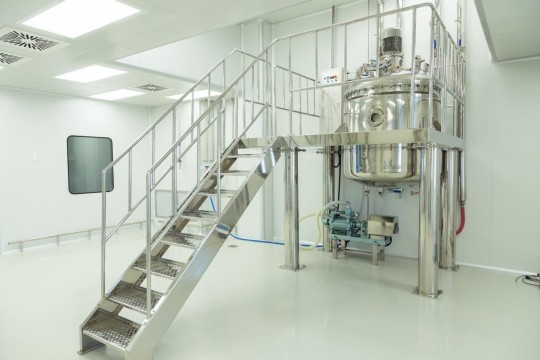
A high level of hygiene has to be maintained in the pharmaceutical industry. Entire production batches can be ruined when there is even slight contamination because of stagnant air or poor ventilation. Here, industrial air circulation fans are used as they help to maintain a clean and sterile environment. With these fans the air is changed constantly and temperature and humidity levels stay within the specified limits.
Commercial wall fans with stainless steel bodies and which run silently are ideal for pharmaceutical plants (closed spaces). They are fitted in wall cavities or in cleanrooms to promote safe airflow while facilitating easy cleaning and maintenance.
Chemical Industry: to make air safe for breathing
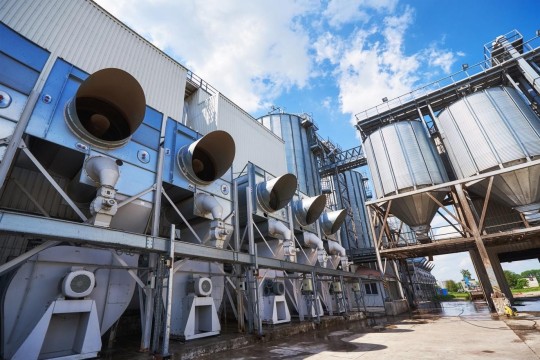
The chemical industry largely deals with volatile substances and fume extraction is of top priority here. By installing industrial ventilation fans that have chemical-resistant blades and motor housing, these would help to avoid corrosion and fire hazards.
Ventilation solutions for industries must be, therefore, tailored to specific risks. For example, for a plant dealing with acids or solvents, it may be wise to choose energy-efficient industrial fans with explosion-proof motors. These fans help to reduce energy consumption and also protect working staff from the dangers of toxic fume build-up. If wall fans for warehouses are used when they are located adjacent to chemical storage units, they can help dissipate toxic fumes effectively.
Why Roof Ventilators Still Matter?
Whereas wall-mounted fans manage horizontal air movement, roof ventilators are designed to ensure vertical airflow, i.e., they push hot, stale air out from the roof. This combination provides a complete industrial cooling solution. For regular maintenance of roof ventilators , here are four key facts to keep in mind:
Clean fan blades and louvers every 3–6 months to prevent airflow blockage.
Check for rust or corrosion on metallic components, especially in chemical plants.
Lubricate the motor and bearings quarterly to reduce wear and energy waste.
Ensure the fan cover or hood is secure to prevent leaks during rain or wind.
Closing Thoughts
The right mix of wall-mounted industrial fans and roof ventilators can transform your textile, pharmaceutical, or chemical factory into a comfortable workplace. It is choosing a reliable industrial wall fans manufacturer that will help you run your facility smoothly.
Investing in the right industrial cooling solutions is not an expense but an investment in safety,1.Which type of industrial fan is best for textile units?
Heavy-duty wall fans and roof ventilators work best to manage heat and humidity efficiently in textile environments.
2. Are industrial fans suitable for pharmaceutical cleanrooms?
Yes, specially designed commercial wall fans with low noise and cleanable surfaces are ideal for cleanrooms.
3. How do ventilation fans help chemical industries?
They remove fumes, control temperature, and prevent corrosion by ensuring constant airflow with ventilation solutions for industries.
#skylight manufacturers#roof ventilators suppliers#riseecovent#solar roof ventilation#wind driven ventilers supplier in thailand#power ventilators supplier in thailand#ecofriendlyventilation#ridge ventilators manufacturer thailand#industrialventilation#roof ventilator suppliers in uae
0 notes
Text
Choosing the Best Solar Roof Ventilation for Australian Homes: What You Need to Know
Looking for the best solar roof ventilation in Australia? Solar roof ventilation systems are an eco-friendly way to improve airflow, reduce heat buildup, and lower energy bills in Australian homes. Designed to withstand the country’s harsh climate, the best solar roof ventilation units offer durable, efficient cooling powered entirely by sunlight. They help protect your roof from moisture and extend your HVAC system’s life. Choose top-rated solar roof ventilation for a sustainable, cost-effective solution to keep your home comfortable year-round.
0 notes
Text
Roof Ventilation Systems That Reduce Moisture and Prevent Mould
Moisture can hide under roof panels and cause serious damage. It weakens timber, spoils insulation and leads to mould. Property owners and installers need reliable solutions. Installing the right roof ventilation systems cuts moisture levels and stops mould growth. Below is a clear path to tackle moisture in roof spaces and keep buildings safe and dry.

Moisture Build-Up in Roof Spaces
Roofs trap heat from the sun. Warm air rises into the roof cavity. When this air meets cooler surfaces it turns into water droplets. Daily activities such as cooking and laundry also release moisture into the air. Without proper airflow, this moisture settles. Over weeks, damp patches form on insulation and timber. Mould can start in hidden spots. It feeds on damp wood and fibres in insulation. Left unchecked it spreads across large areas. Mould spores in living spaces can harm health. Children and people with allergies face higher risks. Repairing mould damage can cost thousands in labour and materials.
How Ventilation Prevents Damp
Good roof airflow works on two simple goals. Let warm moist air escape. Draw in cooler dry air. Passive vents use natural air movement. Eaves vents at the roof edge let air in. Ridge vents along the peak allow air out. This method needs no power. It relies on heat rising. Sometimes passive flow is not enough. On calm days air stalls in the cavity. A powered roof ventilation unit solves that. The fan pushes air out and keeps moisture moving. Combining both types gives the best result. The passive vents provide a base flow. The fan boosts circulation when needed. This mix adapts to all weather.
Actionable Strategies to Control Moisture
Seal Humid Zones
Block paths for moist air from bathrooms and kitchens. Fit exhaust fans that vent outdoors. Keep warm wet air out of the roof space.
Install Balanced Intake and Exhaust
Intake vents must match exhaust vents. If you only fit outlet vents you create a vacuum. Air leaks in through gaps. It can carry moisture with it. Balance intake and exhaust areas to keep the flow steady.
Choose Vents by Roof Type
Tile and metal roofs behave differently. Metal roofs heat and cool fast. They cause more condensation at night. Tile roofs hold heat longer. They can trap moisture. Select vent styles that suit the roof material and pitch.
Follow and Adapt the 1:300 Rule
Aim for one square metre of vent per 300 square metres of ceiling. This is a good starting point. But test the air movement after installation. Adjust vent sizes if air stalls or moisture remains.
Schedule Biannual Checks
Clear any debris that blocks vents. Leaves, dust and bird nests all reduce airflow. Inspect vents before hot weather and before cold weather. Start each season with clear vents.
Monitor with Simple Tools
Use a moisture meter to check timber and insulation panels. A small gadget can spot hidden dampness. Check any area that feels colder. Cold spots often hide condensation zones.
Record Readings
Keep a log of moisture readings and vent inspections. This shows trends over time. You can catch small issues before they turn into large repairs.
Train Installers and Owners
Teach the signs of poor ventilation. A rough patch of timber. A damp smell in the attic. Quick recognition leads to faster fixes.
Common Mistakes with Roof Ventilation Fan Installations
Mixing vent types without testing. A passive ridge vent and a high-power fan can conflict if intake is low.
Venting into the ceiling space instead of outside. This traps moisture under the tiles and in the battens.
Installing vents without weather in mind. Ignoring prevailing winds can block airflow or let rain in.
Forgetting intake vents. Many focus on the outlet vents and leave the entry side under-sized.
Relying on visual checks alone. Wet areas can hide under insulation. Use meters or thermal imaging to verify dryness.
Stable roof airflow keeps moisture levels low. It stops mould at its source. It extends the life of insulation and timber. It protects the health of everyone inside. Choosing the right mix of passive vents and a roof ventilation fan brings balance. Simple checks and clear records make maintenance easy. Small steps early save big repairs later. Think of ventilation as a quiet shield for the whole building. It works day and night. It needs little upkeep. Yet it delivers huge benefits in comfort and cost savings.
#best roof ventilation#Best roof ventilation systems#Powered roof ventilation#Roof ventilation Fan#Roof ventilation systems#Roof ventilation
0 notes
Text
#westville group#cavity wall insulation#cladding#external insulation#home insulation#roof insulation#westville#ventilated home
0 notes
Text
Build Website Authority with Guest Posting & Niche Edits 🚀 -> https://bit.ly/guestpostlegiit
If you’re serious about boosting your website’s authority and climbing the search rankings, it’s time to get strategic with your link-building. Two of the most effective methods? Guest posting and niche edit services. Here’s why these tactics matter and how you can leverage them to transform your digital presence.
Why Guest Posting Works
Guest posting isn’t just about dropping a link and hoping for the best. When done right, it’s a powerful way to:
Get your brand in front of new audiences
Build authentic relationships with high-value partners
Earn high-quality backlinks that search engines love
Establish your expertise in your niche
A professional guest posting service—like the one on Legiit—does more than just publish articles. With 11+ years of proven results, these experts focus on industry-specific knowledge, relationship-driven outreach, and content that actually converts readers into customers. The difference? It’s not about vanity metrics; it’s about real business growth.
What About Niche Edits?
Niche edits (or “curated links”) involve placing your link within existing, relevant content on established websites. This means:
Immediate SEO value from aged content
Natural link placement that search engines trust
Fast results compared to waiting for new content to rank
Combined with guest posting, niche edits create a diverse, authoritative backlink profile that signals trust to Google.
How to Get Started
Ready to level up? Here’s what to look for in a guest posting and niche edit service:
Proven track record (look for real reviews and results)
Focus on quality, not just quantity of links
Transparent reporting and communication
Industry expertise and tailored outreach
Services like those found on Legiit offer detailed reporting, on-time delivery, and a customer-focused approach. With packages starting at $35, you can choose a solution that fits your goals and budget.
“Let me help you craft messages that not only capture attention but create lasting engagement with your target audience. Your digital success story starts here.”
Guest posting and niche edits are your ticket to sustainable website authority. Choose a trusted provider, focus on quality, and watch your rankings (and leads) soar.
Want to see real results? Check out guest posting services on Legiit and start building your brand’s digital footprint today!
#SEO#LinkBuilding#GuestPosting#NicheEdits#WebsiteAuthority#Legiit#HVAC#HVACLife#HVACTech#HVACR#AirConditioning#Heating#Ventilation#HVACService#HVACRepair#HVACContractor#Furnace#Boiler#Ductwork#IndoorAirQuality#EnergyEfficiency#SmartHomeHVAC#ACRepair#HeatPump#HVACMaintenance#Cooling#Roofing#RoofingContractor#RoofRepair#NewRoof
0 notes
Text
#Wall cladding#Guttering and Downpipes installation#Copper Roofing#Metal Roofing#Roof Replacements#Roof Ventilator
1 note
·
View note
Text
Roof Air Ventilators: Enhancing Indoor Air Quality and Comfort
In today's rapidly evolving construction and architectural landscape, ensuring adequate ventilation is paramount. Roof air ventilators are crucial components designed to improve indoor air quality and regulate temperature. This article delves into the significance, types, benefits, and applications of roof air ventilators, shedding light on why they are indispensable for modern buildings.
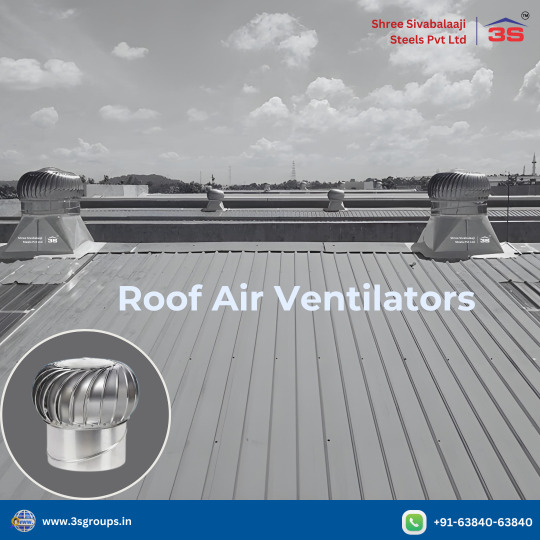
Understanding Roof Air Ventilators
Roof air ventilators are devices installed on the roof of a building to facilitate the movement of air. They work by allowing hot air to escape from the building while drawing in cooler air from the outside. This natural ventilation process helps maintain a comfortable indoor environment, especially in climates where temperatures can soar.
Types of Roof Air Ventilators
Static Ventilators: These are the simplest form of ventilators that do not have moving parts. They rely on natural convection and wind to facilitate airflow. Static ventilators are easy to install and maintain, making them a cost-effective choice for many applications.
Exhaust Ventilators: Designed to remove stale air from the building, exhaust ventilators create a negative pressure that allows fresh air to enter from other openings. These are particularly useful in areas with high humidity or pollutants, such as kitchens and bathrooms.
Mechanical Ventilators: These ventilators use fans or blowers to force air in and out of the building. While they may require more energy, they provide controlled ventilation, making them ideal for larger commercial spaces or buildings with specific airflow requirements.
Whirlybirds: A type of static ventilator that utilizes wind power to spin and draw out hot air. Whirlybirds are popular for their efficiency and low maintenance requirements.
Benefits of Roof Air Ventilators
Improved Indoor Air Quality: By allowing stale and humid air to escape, roof air ventilators help reduce the concentration of indoor pollutants, allergens, and moisture. This leads to a healthier living environment, which is essential for occupants' well-being.
Energy Efficiency: Roof ventilators can significantly reduce the need for air conditioning by allowing hot air to escape and cooler air to enter. This natural cooling effect can lower energy bills, making buildings more environmentally friendly.
Temperature Regulation: Proper ventilation helps maintain a consistent temperature throughout the building. This is particularly important in industrial settings where temperature control can affect product quality and worker comfort.
Condensation Control: In humid climates, condensation can lead to mold and structural damage. Roof ventilators help minimize condensation by promoting air circulation and reducing humidity levels.
Extended Roof Lifespan: By preventing heat buildup and moisture accumulation, roof air ventilators can extend the lifespan of roofing materials, reducing the need for premature repairs or replacements.
Applications of Roof Air Ventilators
Residential Buildings: Homeowners often install roof ventilators to improve air quality and reduce energy costs. In attics, ventilators can help prevent overheating and moisture buildup, protecting the structural integrity of the home.
Commercial Spaces: Retail stores, offices, and warehouses benefit from roof air ventilators by creating a comfortable atmosphere for employees and customers alike. Effective ventilation can also enhance productivity and reduce absenteeism.
Industrial Facilities: Factories and manufacturing plants frequently utilize roof ventilators to manage temperature and humidity levels. This is crucial for maintaining product quality and ensuring worker safety in environments with potentially hazardous materials.
Agricultural Buildings: Barns and greenhouses often incorporate roof ventilators to maintain optimal growing conditions for plants and livestock. Proper airflow helps control temperature and humidity, promoting healthy growth.
Choosing the Right Roof Air Ventilator
When selecting a roof air ventilator, several factors should be considered:
Building Type: The design and purpose of the building will influence the type of ventilator needed.
Climate: Local climate conditions, such as humidity and temperature variations, should guide the choice of ventilator type and size.
Installation Requirements: Consideration of the ease of installation and maintenance is crucial, especially in larger projects.
Energy Efficiency: Opt for ventilators that complement the building's energy-efficient design to maximize benefits.
Conclusion
Roof air ventilators play a vital role in enhancing indoor air quality, regulating temperature, and improving overall comfort in residential, commercial, and industrial buildings. With their various types and numerous benefits, investing in roof ventilators is a proactive step toward creating healthier, more energy-efficient spaces. For more information on roof air ventilators and other ventilation solutions, visit 3sgroups.in.
0 notes
Text

24 inch Soffit Vent | ASA Base Resin with UV Protection
Shop rectangular soffit vent in white ASA resin with UV protection. This 24-inch soffit vent is durable and USA-made, ideal for efficient soffit ventilation.
1 note
·
View note
Text
Green Attic Insulation Contractor Chicago, IL
Green Attic Insulation, founded in 2009 in Chicago, is a leading provider of sustainable home improvement solutions. Specializing in insulation, energy audits, and eco-friendly upgrades, the company combines innovation, quality service, and environmental commitment to enhance comfort, reduce energy costs, and support greener living for homeowners across the Chicago area.

#attic#attic insulation#attic ventilation#energy efficiency#energy efficient hvac#energy efficient roofing#green attic
1 note
·
View note
Text
Quantifying Biophilic Design | The Role of a Cost Estimating Service
Biophilic design, a concept that integrates natural elements into built environments, is no longer a trend—it’s becoming a core philosophy in architectural practice. From living walls and indoor gardens to daylight maximization and water features, these nature-inspired components enhance user well-being, increase productivity, and elevate the aesthetic quality of spaces. Yet, as beautiful and functional as biophilic design may be, it presents financial complexities that must be addressed early in project planning. This is where a cost estimating service plays a critical role.
With expertise in translating conceptual design into measurable costs, firms like AS Estimation & Consultants help developers, architects, and contractors bring biophilic elements into projects without losing control of the budget. Their detailed assessments provide a clear picture of how nature-driven features impact construction costs, lifecycle expenses, and return on investment.
Bringing Nature into the Budget
Biophilic design includes a range of interventions—from skylights and green roofs to natural materials and acoustically engineered water elements. These features can greatly enhance occupant experience, but each one carries a cost. A cost estimating service ensures that these costs are fully understood and quantified before they become financial burdens mid-project.
For instance, installing a vertical green wall may require additional irrigation, lighting, and structural support. A cost estimator will itemize all associated components, including installation labor, ongoing maintenance, and energy usage, providing stakeholders with a full financial picture.
Comparing Natural Materials to Conventional Alternatives
Natural materials such as timber, stone, rammed earth, and reclaimed wood are common in biophilic design. While often preferred for their tactile quality and environmental benefits, these materials may come at a premium, especially if regionally sourced or custom fabricated.
A cost estimating service evaluates these materials not just on their purchase cost but also on their availability, sourcing logistics, installation needs, and long-term performance. This enables clients to make value-driven decisions. For example, AS Estimation & Consultants may recommend thermally treated timber over exotic hardwoods, balancing sustainability, aesthetic quality, and cost-efficiency.
Evaluating Daylighting and Ventilation Strategies
One of the most beneficial aspects of biophilic design is the emphasis on daylighting and natural ventilation. However, maximizing natural light involves strategic window placement, increased glazing, and sometimes structural alterations, all of which affect the budget.
Estimators assess how increased glazing impacts thermal insulation requirements, HVAC loads, and structural support systems. They also analyze how these changes influence energy consumption and long-term operating costs. A proper cost-benefit analysis helps decision-makers weigh the upfront investment against expected energy savings and productivity gains.
Quantifying Return on Wellness Investments
Biophilic design is well known for its positive impact on mental health, stress reduction, and workplace productivity. While these benefits are harder to quantify in monetary terms, a cost estimating service can still model the financial return from these wellness-driven investments.
In commercial settings, improved employee well-being can translate to fewer sick days, lower turnover, and higher engagement. In residential or hospitality projects, enhanced occupant experience can boost property value and customer satisfaction. Cost estimators can use benchmark data and case studies to forecast these indirect returns, supporting business cases for biophilic features.
Incorporating Water Elements and Sensory Features
Water features, another hallmark of biophilic design, range from indoor fountains to reflecting pools and natural filtration systems. While they create soothing environments and acoustic balance, their installation and maintenance can be complex.
A cost estimating service breaks down these features into detailed cost components—pumping systems, water filtration, structural waterproofing, and operational upkeep. AS Estimation & Consultants provides these insights in a way that allows for scaling or substitution without compromising the design intent.
Maintenance Planning and Lifecycle Costing
Many biophilic design features have ongoing maintenance needs. Living walls need pruning and irrigation, water features require cleaning, and daylight-optimized buildings may need higher-spec glazing with better solar control.
A cost estimating service takes these factors into account by preparing lifecycle cost reports. These include not just initial capital costs but also future operational expenditures, allowing clients to plan for sustainability both financially and functionally. This is especially useful for public projects, healthcare facilities, and long-term commercial leases.
Enhancing LEED and Green Certification Potential
Biophilic elements often contribute to sustainability benchmarks like LEED, WELL, or Green Star certifications. These certifications, while offering long-term environmental and financial benefits, come with their own set of compliance costs.
Estimators work in tandem with sustainability consultants to assign costs to credit-earning features—like low-VOC finishes, natural ventilation, and indoor greenery—helping clients understand the investment required to achieve certification goals. AS Estimation & Consultants frequently includes certification cost modeling as part of its preconstruction services.
Conclusion
Biophilic design has the power to transform how people interact with built environments, offering both emotional and tangible returns. However, without a clear understanding of the associated costs, these benefits can be lost to budget overruns or missed opportunities. A cost estimating service brings clarity, accuracy, and foresight to the process, ensuring that the integration of nature into architecture is as financially sound as it is visually and functionally impactful.
With expert services from AS Estimation & Consultants, developers and architects can embrace biophilic design with confidence—knowing that every living wall, skylight, and water feature is accounted for with precision and purpose.
#biophilic estimating#nature-based design costs#green wall pricing#cost estimating service#daylighting budget#timber cost planning#acoustic water features#AS Estimation & Consultants#lifecycle costing#green roof estimating#natural ventilation costs#natural material pricing#LEED cost estimating#wellness ROI#biophilic construction costs#sustainable building costs#reclaimed wood estimates#indoor plant systems#glazing and light costs#green design budgeting#WELL certification costs#eco-feature estimating#living wall maintenance costs#smart sustainability planning#green space valuation#urban wellness design#energy savings estimate#healthy building estimating#water feature cost breakdown#sustainable cost management
0 notes
Text
Roof Repairs & Restoration in Melbourne By Taylor & Son Roofing
Taylor and Son Roofing provides emergency roof repairs, restoration, cleaning & leak services in Melbourne. With our experienced guttering contractor you will get the best solution for your Roof. Call us on 0402 439 107!

0 notes
Text
Looking for high-performance Industrial Wall Fans? RiseEcovent offers durable, energy-efficient wall-mounted fans with advanced shutter systems designed for factories, warehouses, poultry farms, and commercial spaces.
✅ Centrifugal push-pull shutters ✅ Windproof, dustproof, and rainproof design ✅ High airflow & low maintenance ✅ Available for bulk orders ✅ Shipping to Thailand, Dubai, Vietnam, Oman, Qatar & across India
📞 Contact us today for best prices and product details! https://www.riseecovent.com/contact-us.php
#skylight manufacturers#solar roof ventilation#roof ventilators suppliers#riseecovent#wind driven ventilers supplier in thailand#power ventilators supplier in thailand#roof ventilator suppliers in uae#ridge ventilators manufacturer thailand#industrialventilation#ecofriendlyventilation
0 notes